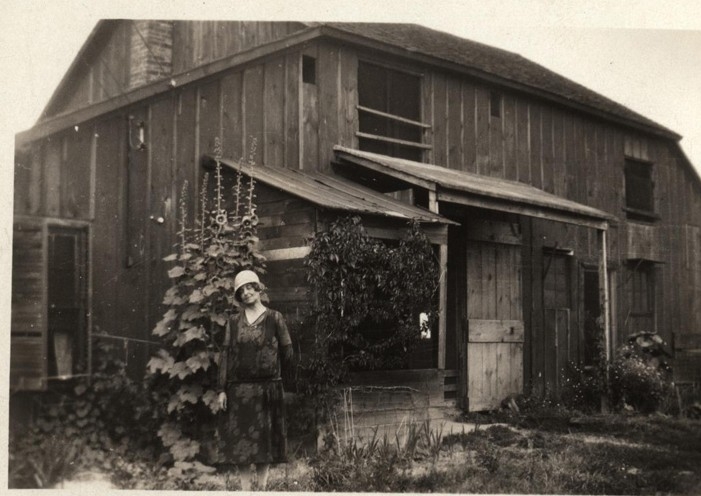
Agnes Ann Inglis
Agnes Ann Inglis was born in 1870 in Detroit, Michigan, the youngest child of prominent Detroit physician Dr. Richard Inglis and Mrs. Agnes Lambie Inglis. The family was financially comfortable, respected in the community, conservative and faithful members of the Presbyterian Church, and though Dr. Inglis died in 1874, the circumstances of daily life for the four-year old Agnes changed very little. She went to Sunday School, later attended the Clay Grammar School and Capitol High School in Detroit, and spent a year at Abbot Academy in Andover, Massachusetts.
After her year in Andover, Agnes returned home, taught Sunday School and cared for, first, her older sister, stricken with cancer, and then her mother.
About 1900, both her sister and mother died and, for the first time in her life, at the age of thirty, she found herself without either family responsibilities or the family home as she had always known it. With an independent income from her parents' estate and very little experience of the wider world, she did what many young women in similar circumstances have done: she traveled abroad, spent a year at the University of Michigan, and went into settlement work.
From the Franklin Street Settlement House in Detroit, she went to Chicago and lived and worked in Graham Taylor's settlement, called the Commons. However, as she says in her unpublished "Reflections," "the longer I worked at it, the less uplifting appealed to me...We taught [the poor] many things,... but not how to reduce the cost of living except by being more frugal than we ever expected to be ourselves."
Back in Michigan, she returned to Ann Arbor, where another sister, Catherine (Mrs. Andrew F.) Smith, lived with her husband and family. First in a small cottage on Geddes Road and then in a house on Wilmot Street, both of which she owned, Miss Inglis offered hospitality and temporary haven to social worker friends from Detroit and elsewhere, as well as entraining nieces, nephews, students, and other University acquaintances. She also continued her "uplifting," as a Sunday School teacher and a volunteer with the YWCA.
An Internal Revolution
t was in Ann Arbor, and in particular in her work at the YWCA with young working women, that Miss Inglis' own internal revolution began. For a while, she worked as a State Inspector when a minimum wage law for women was under consideration by the legislature, a job which took her into factories, shops, saloons and other places where women were employed. She was grateful that her independent income saved her from what she saw in other women's lives, but grew increasingly uncomfortable that her income was "unearned" and came from rent paid by just such women, immigrant workingmen, and other poor people. She went to meetings and lectures, read a great deal, observed even more, talked to people, listened and thought, and by 1912 or 1913 considered herself an anarchist and was actively involved with radical affairs.
She met Emma Goldman and John Beverley Robinson, an anarchist writer who had retired to the home of his son, in Ann Arbor. She came to know Judson Grenell, Joseph A. Labadie and other labor activists in Detroit, and she joined the Industrial Workers of the World. When the arrests of IWW leaders and other radicals started about 1917, she posted bail for many of them and participated actively in the unsuccessful struggle to save friends and fellow activists from prison and deportation. By the early 1920's, the unearned income that had so troubled Miss Inglis' conscience was gone, and she was once again living in Ann Arbor, largely dependent on an allowance from her brother, James, a very successful businessman whose large and elegant home was bequeathed to the University and is still known as Inglis House.
A Life's Work Begun as a Volunteer
In 1924, pursuing some research of her own, Miss Inglis inquired after the extensive collection of early labor and other radical materials donated to the University of Michigan in 1912 by Joseph A. Labadie, and learned it was still packed away in boxes. Shortly thereafter, she volunteered to unpack and sort the contents of the boxes. By 1926, she had come to recognize that the Labadie Collection was her life's work.
Until her death in 1952, at the age of eighty-one, Miss Inglis devoted herself, largely without pay or official recognition, to enlarging and "fixing," as she called it, the personal papers and correspondence, tracts, pamphlets, shop papers, handbills, minute books, union badges and credentials, and publications of numerous radical political and social reform organizations that constituted the original Labadie gift. She was, of course, without library or archival training, and her methods of organization and of providing bibliographic access to this heterogeneous clutter of materials were, from a latter day perspective, often eccentric. But unlike the academic establishment in the midst of which she lived and worked, largely invisibly, she knew the value of the material with which she worked. During Agnes Inglis' 26 years as Curator of the Labadie Collection she enlarged it perhaps twenty-fold, almost entirely through gifts and donations. Starting with her own circle of friends and acquaintances, she corresponded tirelessly with a wider and wider network of radicals and their families and friends, informing people about the Labadie Collection and soliciting gifts of papers, books, pamphlets, journals and memorabilia. Inglis' contributions toward documenting the radical movement of her time have proven invaluable.
Biographical information and photos reprinted with permission of the Joseph A. Labadie Collection.